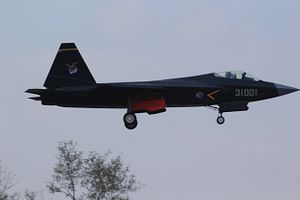Who’s going to buy the J-31?
The recent appearance of the aircraft at the Zhuhai airshow, as well as the comments of a smattering of Chinese officials, led to a spate of articles suggesting that China was interested in the J-31 primarily as an export model. Conceivably, the J-31 could occupy a low-end stealth fighter niche that currently has no other entrants.
Some have billed the J-31 as China’s answer to the F-35, as if that represented some sort of compliment. It’s hardly a stretch to suggest Pakistan would be a major customer, and perhaps Egypt as well. Beyond that? The United States can offer the F-35 to a wide range of European and Asian countries, all of which have strong economies, big defense budgets, an appetite for high tech, and an interest in cementing the long-term technological and political relationship with the United States.
Beijing doesn’t have the kind of friends that would do it the favor of buying something like the F-35. If the sanctions on Iran ease up in the wake of a successful nuclear deal, Tehran will be looking to buy advanced fighters. If the Assad government ever manages to win its civil war, it too will need new fighters, but probably won’t be able to afford anything like the J-31. The Gulf monarchies buy weapons in order to create political ties, and are unlikely to shift their attention from Washington to Beijing unless the international system changes in immense and unforeseen ways.
Malaysia and Indonesia have been known to make adventurous decisions with respect to fighter purchases, but given the tensions in the South China Seas, it’s unlikely that China would want to significantly increase their capabilities, or that they’d want to tie themselves to Chinese support. Several Latin American countries may soon recapitalize their air forces, but the Europeans seem to have a leg up in that market, and thus far the Latin Americans seem satisfied with reliable generation 4.5 fighters.
Russia and India, of course, are right out.
At this point, no one has a good sense of how much the J-31 might cost, or how the Chinese might try to package it. If the J-31 resembles the F-35 in anything but superficial terms, the system add-ons will matter as much as the airframe itself. The F-35, after all, sells itself as the center of a system of sensor and communications systems that facilitates air command. This system requires a variety of other components (drones, EW aircraft, satellites), and the system is enhanced by the capacity of F-35s to work together to create a more accurate vision of the battlespace.
There’s no indication as of yet that the J-31 is supposed to have these kinds of emergent capabilities, and there’s little sense that China is capable of developing and exporting such systems along with the airframe. America’s friends buy the F-35 because they worry that their legacy aircraft won’t be able to coordinate effectively with U.S. planes in multilateral combat situations. China doesn’t have this kind of relationship with anyone, and consequently can’t make one of the biggest cases for buying a fifth generation fighter.
Competing with the F-35 requires more than developing an effective airframe. The F-35 remains attractive not because it’s awesome, but because it’s embedded in a larger set of political and technological relationships. China has a lot of work to do before it can compete with that.
































